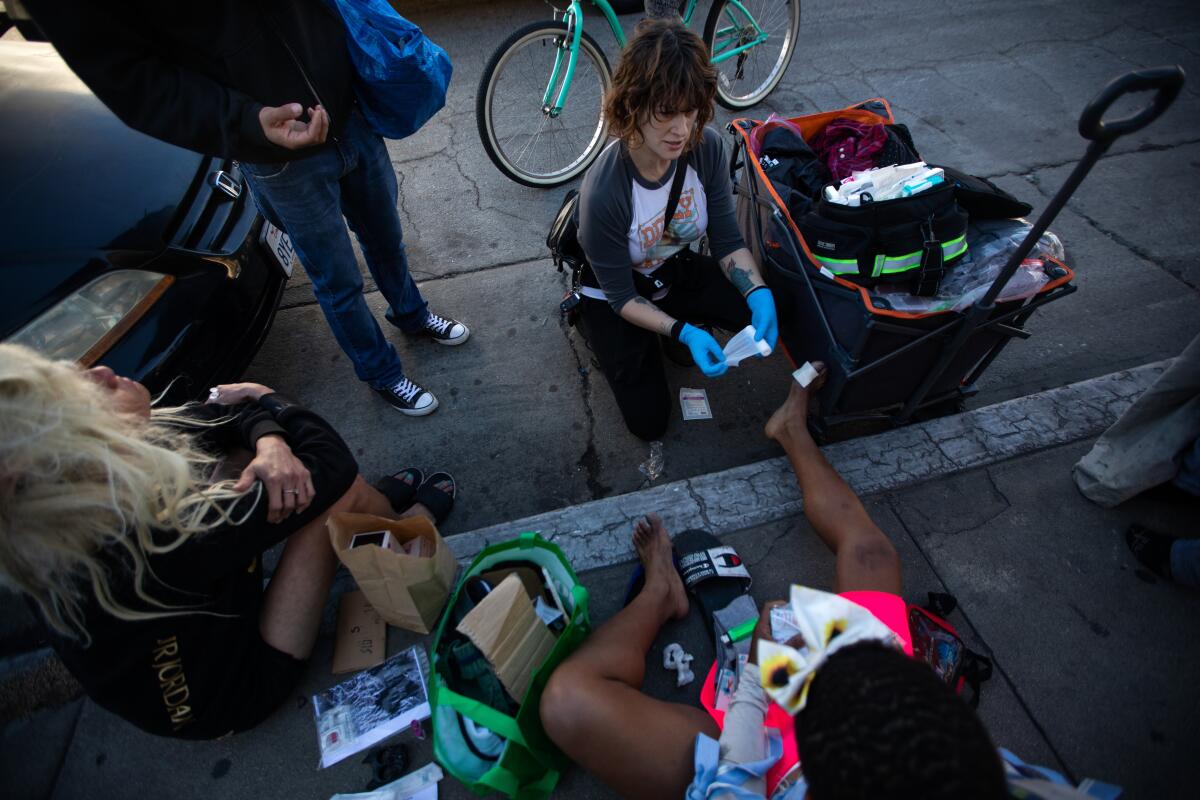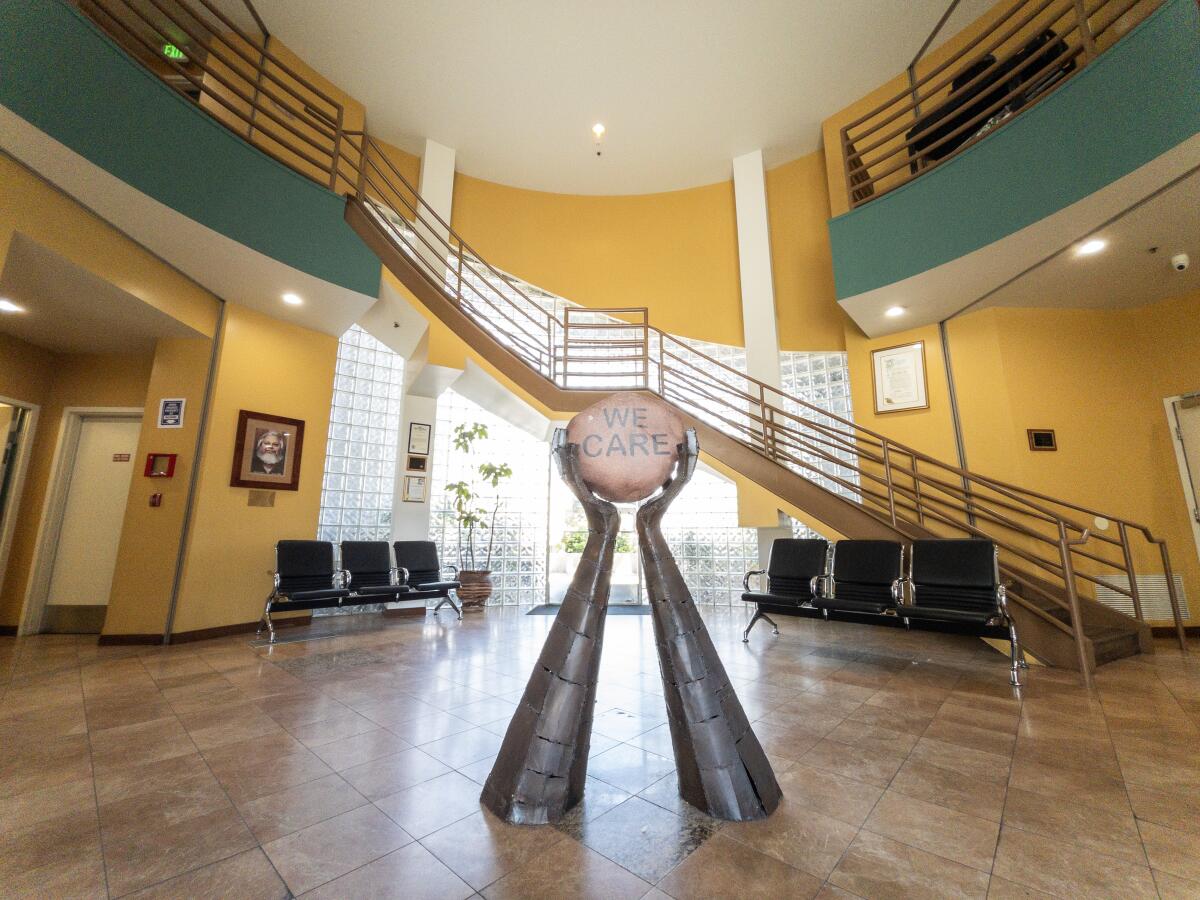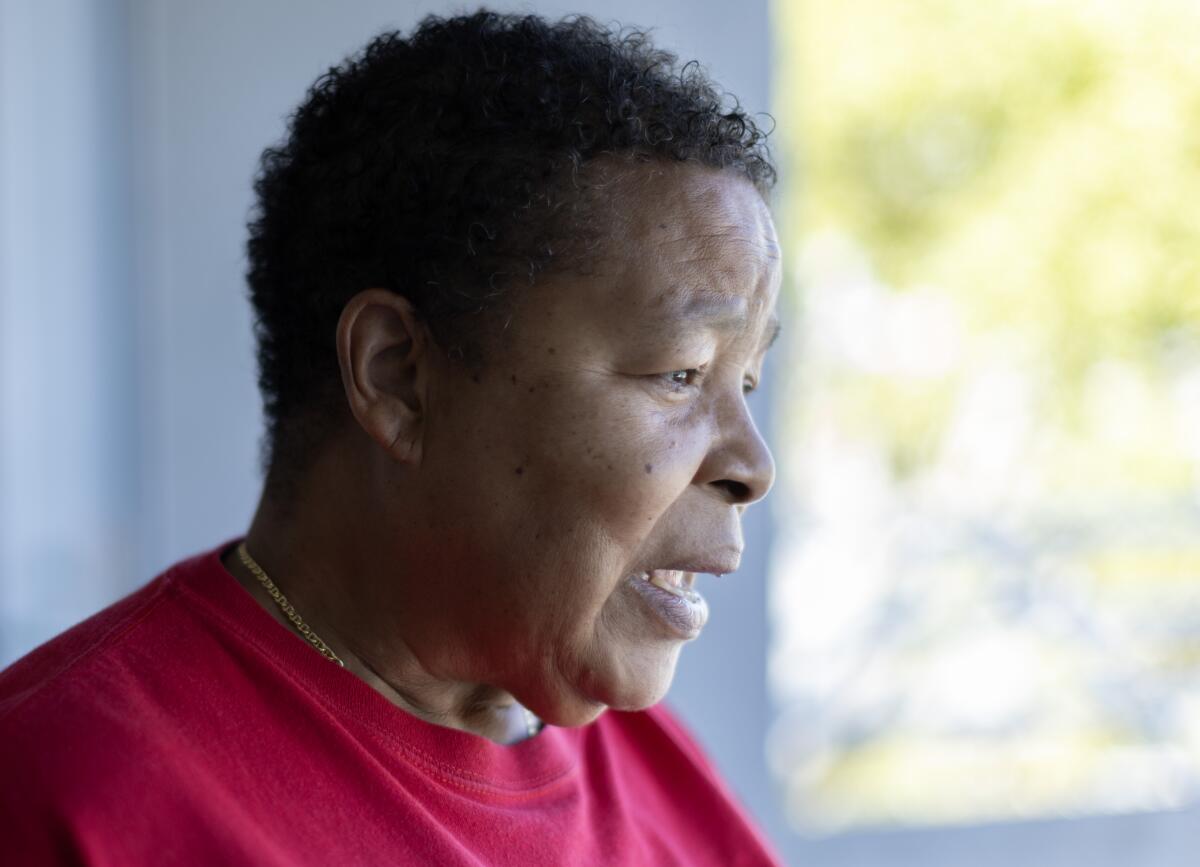Gary Horejsi wrestled with the decision before him, knowing a life could be in his hands.
It was the third time that the woman had used drugs or alcohol since coming to CRI-Help, which runs a 135-bed residential facility in North Hollywood where people are treated for substance use disorder.
CRI-Help needed to be a safe place for people grappling with their addictions. In the past, others had been removed for less. Horejsi, the clinical director, had the final say on whether she should be discharged.
He perused her file on his computer. The woman was still trying, CRI-Help staffers told him. She hadn’t shared drugs with anyone. And if she were to leave, the risks of an overdose were graver than before.
Horejsi decided to let her stay.
“Things can’t be business as usual anymore,” their chief executive, Brandon Fernandez, later said at a CRI-Help staff meeting. If someone leaves treatment and resumes using drugs the same way they were before, “that could very well look like them dying.”
“So are we going to be willing to do something different?”
“Things can’t be business as usual anymore,” CRI-Help Chief Executive Brandon Fernandez told his staff at a meeting in North Hollywood on April 10.
(Myung J. Chun / Los Angeles Times)
Fernandez had gathered CRI-Help staff in their North Hollywood conference room to talk about a Los Angeles County initiative that could reshape such decisions. It’s called Reaching the 95% — or R95 — and its goal is to engage with more people than the fraction of Angelenos already getting addiction treatment.
Across the country, more than 48 million people had a drug or alcohol use disorder, according to the latest results from the National Survey on Drug Use and Health. Only 13 million received treatment in the previous year. Among those who did not get treatment, roughly 95% said they did not think that they should.
Those numbers have collided with the grim toll of fentanyl, an especially potent opioid that has driven up deaths across the country. In Los Angeles County, the number of overdose deaths tied to fentanyl skyrocketed between 2016 and 2022, soaring from 109 to 1,910, according to a county report.
“We can’t just take the approach that we’ve been taking and kind of assume that everyone wants the services that we offer,” said Dr. Gary Tsai, director of the Substance Abuse Prevention and Control division at the L.A. County Department of Public Health. “That’s just not the reality.”
His department is trying to nudge addiction treatment facilities to change their approach, by offering financial incentives for those that meet R95 requirements. Among them: changing their rules to not automatically eject people who have a “lapse” of drug use.
Fernandez, whose organization is participating in R95, said abstinence is still its aspirational goal — and “we still have the ability to use our own clinical judgment on a case-by-case basis,” such as if people endanger other participants. But “we shouldn’t have blanket policies.”
To get R95 funding, they also cannot require people to be totally abstinent before being admitted. And under R95, treatment programs are also being encouraged to partner with syringe programs rooted in “harm reduction” — a philosophy focused on minimizing the harmful effects of drug use — to address the needs of people who may not want to enter or remain in treatment.
Some treatment providers “view us as the enemy instead of as allies,” said Soma Snakeoil, executive director of the Sidewalk Project, which provides Narcan spray to reverse overdoses and other services on L.A.’s Skid Row.
With R95, she said, “the biggest change is that harm reduction organizations and treatment providers are talking to each other in a way that was not happening before.”

Soma Snakeoil, executive director of the Sidewalk Project, gives first aid to a woman with an open wound on her foot last year in Los Angeles.
(Francine Orr / Los Angeles Times)
The county is also prodding addiction treatment facilities to reexamine whether the way they operate could be turning people away, and look more closely at the “customer experience.” Tsai compared the situation to a restaurant drawing few customers: “How do we get more people in the door?”
Too often, “the drug dealers do a much better job of delivering their product to our patients than we do,” said Dr. Randolph Holmes, chair of government affairs for the California Society of Addiction Medicine.
When Johnny Guerrero decided to get off Skid Row and go into residential treatment in Los Angeles, he was initially turned away because he had arrived “late — maybe 10 minutes late,” the 35-year-old said.
He was only able to get in, he said, because the harm reduction worker who had taken him to the facility let him stay the night at her home, then brought him back the next morning. Even then, “there was so much paperwork. I was so dopesick. There was just hurdle after hurdle after hurdle.”
“They did not make it easy for an addict to get help,” Guerrero said.
In many cases, “the biggest barrier is just being able to get somebody on the phone” with a treatment provider, said Amanda Cowan, executive director of Community Health Project LA, which provides clean syringes and other services to people who use drugs. “When people are ready, they are ready in that moment.”
As of late March, roughly half of the addiction treatment providers that contract with L.A. County were on track to become “R95 Champions,” which could yield hundreds of thousands of dollars each in additional funding.

CRI-Help’s George T. Pfleger center in North Hollywood.
(Myung J. Chun / Los Angeles Times)
To get those funds, they must turn in admissions and discharge policies that adhere to the R95 guidelines, as well as an “engagement policy.” They are also supposed to meet R95 requirements in one other area of their choice, which could include a “customer walkthrough” to see what might turn away clients.
CRI-Help, for instance, had decided to change how it asks newcomers to undergo a search. “The last thing we want to do is trigger someone’s trauma history and potentially have them walk out the door,” Fernandez said.
To ensure it was consistently done with sensitivity, CRI-Help drew up a script for staffers, emphasizing that consenting to a search would help maintain a safe facility. The hope is that “they feel they’re doing something as a part of a community — versus being forced to undergo something that’s uncomfortable.”
Staffers also tell them that if they have any drugs to hand over, “there’s not going to be any consequence, you can still come into treatment,” Fernandez said. “And if we find them on you, there still won’t be any negative consequences.”
The L.A. County push comes as state and federal officials have stressed the need for “low barrier” approaches to addiction care. Even cutting back on drug use can have positive results, researchers have found.
But some of the changes can be at odds with long-standing beliefs among treatment providers, many of whom got into the field after successfully battling their own addictions in programs firmly focused on abstinence.
Many in the field think “this is what works” because it did work for them, said Vitka Eisen, chief executive of HealthRight 360, another R95 participant. But “we’re the survivors, and we don’t talk to those who didn’t survive.”
Addiction researchers have long called to reexamine how people are treated for substance use disorders. More than a decade ago, a Columbia University center found that “much of what passes for ‘treatment’ of addiction bears little resemblance to the treatment of other health conditions.”
“This is inexcusable given decades of accumulated scientific evidence attesting to the fact that addiction is a brain disease,” the National Center on Addiction and Substance Abuse lamented in its report.
Experts argue that part of the problem is that addiction treatment has long been separated from the rest of the healthcare system. Richard Rawson, senior advisor to UCLA Integrated Substance Abuse Programs, said a major shift was the emergence of buprenorphine, a medication for opioid addiction that could be prescribed in ordinary clinics just like medicines for other chronic conditions.
But some Southern California treatment providers have viewed using buprenorphine and other such medications as short of sobriety, UC San Diego researchers found — even as California has ushered in requirements for licensed treatment facilities to either offer or help people access such medications.
Addiction is now much more widely understood as a medical condition, but “how much of that philosophy actually gets down to the level of the counselor?” Rawson said. “I think that’s still a work in progress.”
Tsai said a challenge in rolling out R95 is the ingrained idea that “you’re ready or not” for substance use treatment. But “we don’t actually treat any other health condition that way,” he said. “You don’t tell someone with diabetes, ‘Your blood sugar has to be completely under control, and then you’ll be ready for treatment.’”
In North Hollywood, counselors and other CRI-Help employees seated around the conference table studied the R95 goals printed on an L.A. County handout. One staffer said she was struggling with a specific statement, particularly for people in a residential setting: “Requiring abstinence is too high of a bar” for treatment.
Fernandez decided to share his own story. More than a decade ago, he was struggling with drug use, which had worsened after the death of his father. He was unemployed and didn’t have a stable place to live. When an outpatient counselor suggested residential treatment, he initially brushed off the suggestion.

CRI-Help’s staffers had questions and concerns about the changing approach to addiction treatment but ultimately seemed supportive.
(Myung J. Chun / Los Angeles Times)
He changed his mind after a “tough weekend,” but had no intention of abstaining from all drugs in the long term. Fernandez said he was nonetheless welcomed at CRI-Help: “Let’s just help you out for now.”
“I came here begrudgingly with a total attitude that I was going to continue smoking weed when I left treatment. I definitely wasn’t going to stop drinking,” even as he recognized that other things he was doing might be a problem, Fernandez told the CRI-Help employees.
Among those who had gone to treatment, he asked the group, “were you ready for total abstinence on Day One?”
“No. That wasn’t even my plan,” the same staffer replied with a rueful laugh.
Still, she and others were anxious about how they would keep everyone safe if clients used drugs, especially if they tried to bring them into the facility. “That worries me a little bit,” she said.
“It worries me too,” Fernandez said.
What preoccupies CRI-Help staff is how to balance the needs of people who have had a “lapse” into drug use with maintaining a safe environment for other clients grappling with addiction.
Horejsi said in an interview that whenever someone uses — even if they don’t share their drugs — “everyone knows, and that in itself does have an effect on people. Sometimes people will feel less safe.”
But Horejsi stressed to the group that “we’re already not discharging people for using” alone.
When people have relapsed, the North Hollywood center has monitored them one-on-one in its television room until staff are sure they are safe, then decided on their next steps. Some have ultimately been moved to another CRI-Help residential facility to continue getting treatment and have a “fresh start,” he said.
The clinical director also urged his co-workers to look back at the many changes CRI-Help had already undergone, such as starting to offer medication for addiction treatment. He reminded them that years ago, CRI-Help clients could be discharged if a doctor had given them an opioid pill at the hospital.

Mary Grayson, a longtime staff member at CRI-Help, spoke positively of the organizations changes over the years.
(Myung J. Chun / Los Angeles Times)
“What about when we discharged people because they talked about getting — they glorified drugs?” said Mary Grayson, a longtime CRI-Help employee.
Leaning forward in her seat, Grayson reminded her co-workers that “CRI-Help is not what it was when I walked through those doors 25 years ago — thank God!”
It started with “two shacks on this property. Two raggedy shacks. And look at where we are now,” she said. “Without us changing and growing, we won’t be able to be who we are.”


